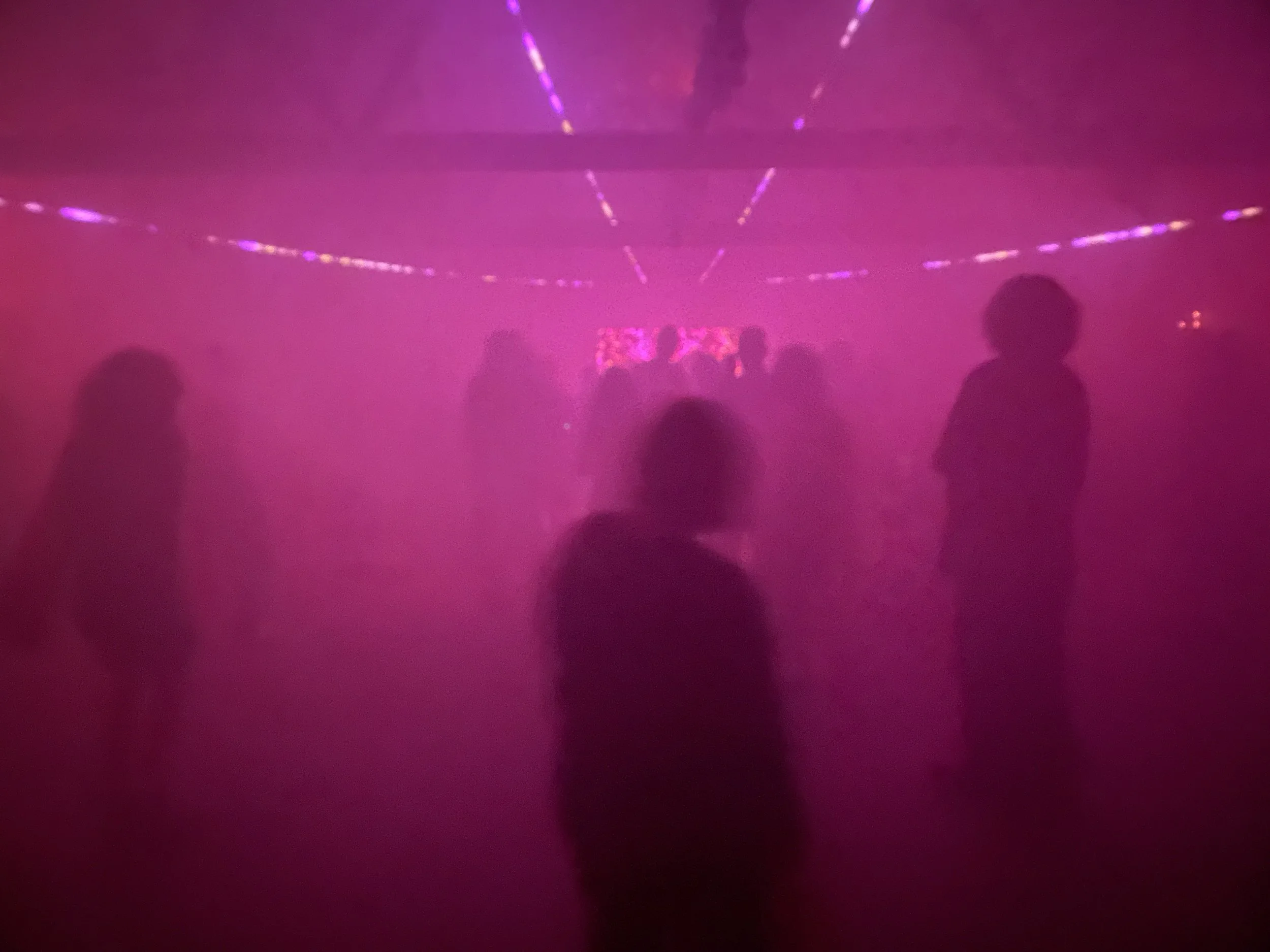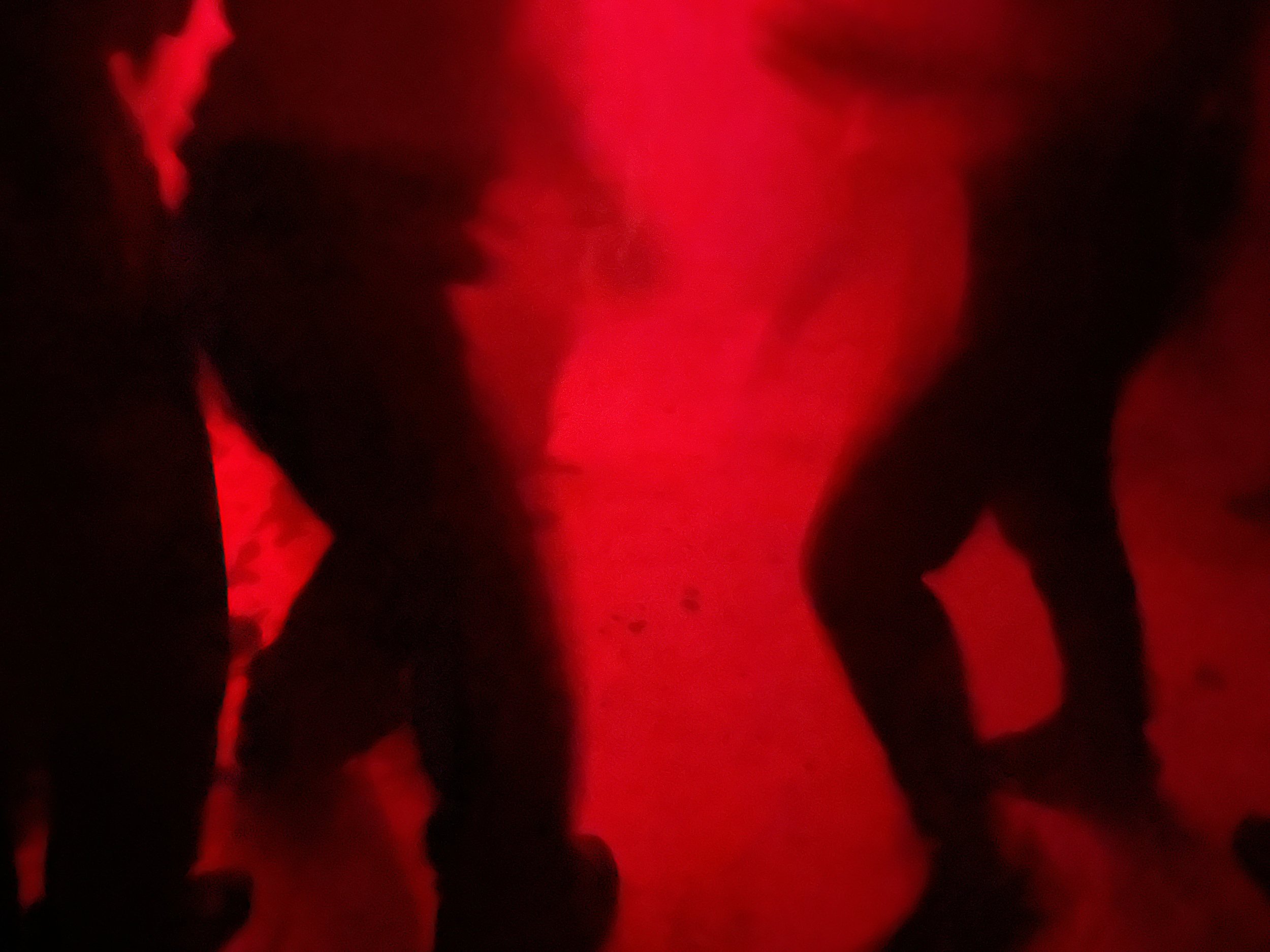Deserters’ Dance
McKenzie Wark
This text is commissioned by PRAKSIS, Dilettante Army, Karmaklubb* and IGWTLI publishing.
It was one of those raves that’s more a labor of love than a business proposition. I won’t give details. I don’t think those involved particularly want any documentation of its existence. Some things might be best kept off the cultural radar. Sometimes it’s better to be discreet, to put out on decoy for those who want an avant-garde, who want to be seen where something is “happening.”
The problem with an avant-garde is that it wears itself out in the cultural fight, slows down, and the main force of the culture catches up with it. Then its existence becomes reified, an artifact stopped in time. Its blazons stripped from its body, waved about in the name of nostalgia. Turned against the young for having missed it.
Then there will be novels about it, like Reinald Goetz’s Rave, perhaps. Or photo books. There’s a beautiful one called Tresor: True Stories[1]. I used it when writing my book Raving as I remember very little about being taken to Tresor back in the day. Next thing you know what was once an avant-garde is listed with UNESCO as intangible cultural heritage. The avant-garde becomes a tourist attraction.
Actually, we don’t have to put up decoys to distract those hungry for trinkets of prestige. We can let others do it for us. There’s plenty of people in New York who want to create the aura of an avant-garde around some fantasy of a revived “downtown.” They are eager for attention, and none too choosy about who gives it and on what conditions. It’s helpful to have someone else contrive to attract the light.
We don’t want to be an avant-garde. An advance force? In advance of what? After us, the deluge. Literally—New York will be swallowed up by the rising tides. Let’s be deserters. Let’s slink off, into the night, in search of sideways time. The less said about where and when and who was there, the better. Let be deserters. Regrouping in the night where we’re not seen by anyone other than deserters.
Many people say to me, “oh, I used to be a raver!” Well, why aren’t you now? Was it just a rite of passage, a last gasp of youth before settling down? It was for me, for a time. Then I came back. Not back among the twenty-somethings. I’ve no desire to run into my own students. I found those who stick with it, who need it, who are attempting to maintain.
It’s a term from an obsolete junkie lexicon: To maintain is to keep your habit alive and yourself alive at the same time. The rave is our habit for living with our other, more demanding habit. How are we to maintain a life in this era when we have all become—to deploy another junkie word—users. All our interfaces with the world treat us as users. We’re all being sucked into the life, where the life is just staring at screens and jabbing at interfaces.
How is it possible to maintain oneself as a user? Maybe by changing our relation to the technics that precedes us and makes us. Maybe that’s what a good rave is. A different relation to the technics we can’t quit, but might use in a different way. Turn some corner of technics towards our need, so that we might find some other relation to it other than user.
So here we are then: a bunch of deserters. Off our screens for a while. Off our heads. A bunch of users away from our keyboards, able to confront the awful, intimate presence of each other’s sweat-sheened flesh because of the skillful deployment of the technics of light, sound, and a careful door policy that tilts towards deserters who know what’s what.
Sometimes all that happens is getting some exercise. That’s not a bad thing. I find exercise boring, but if the DJ is good I’ll dance for hours. It is a DJ’s most basic job: to keep you moving your body past the point where you would have given up for a cig break. Sometimes, walking home after the rave, I say to Jenny, my girlfriend and rave partner, “well, at least we got a workout!” It’s no accident that the Brooklyn raver uniform leans towards gym clothes, in black.
Back to the rave in question: it was more than a workout. It was everything. At least for the stretch from 4AM on. I don’t know what happens at peak hours—generally midnight through to 3AM or so. I rarely go then. Raves have a lot of uses for a lot of people. I’m not so interested in the peak hours vibe.
By 4AM it will be down to the hard core. Those who really need it. Those who need to maintain. Those who’ve built themselves into endurance dancers. Legal nightlife in New York usually shuts down at 4AM as that’s when alcohol sales have to end. Service workers in nightlife as an industry illegal come by the rave after then and treat it as an afters. So do sex workers, who are usually done with clients by then too. It’s a good crowd.
If I name the DJ that will give things away. Let’s just say its someone well known, who has played big festivals, tours a lot, has a following in many lands. I’ll just call her Mother. This is Mother’s hometown crowd. Many of us have been coming to dance to her for years. Felt her grow, expand, become iconic.
Mother has a special relation to the dolls and their familiars. All dolls are trans women, but not all trans women are dolls. I’m not. Doll culture centers Blackness, nightlife, sex work, high femme style. The daylight world offers them nothing, so they take their place in the night. Their presence at a rave is a blessing bestowed, although not all promoters feel that way as they’re disinclined to pay their way.
There’s no formula for a perfect rave. Like grace, it comes, or it doesn’t, although there’s some things that might encourage it. A good venue, well arranged—a constructed situation. Good lighting and sound. A DJ line-up that makes sense and flows through the night. The right crowd. The kind who are giving. No tourists, no spectators, expecting others to entertain them. Door people who are friendly but strict, who filter for ravers. Security who search only for weapons, not drugs.
And of course, drugs Most nightlife is alcohol-fueled, although I don’t think it’s the best mood modifier. The elation is short-lived, then its depressive. One reason I like the morning stretch is the drinkers have mostly gone home. I came of age through the cocaine era and then the ecstasy era. When there’s one dominant drug, that shapes the sensory and emotional space for everyone, whether they are on it or not.
These days the best raves seem to me to be poly-intoxicant. There’s molly and ket, cocaine and GBH, mushrooms and acid. Some of those other drugs that are just a bunch of letters and numbers that I haven’t tried. A poly-intoxicated dancefloor has several perceptual and emotional distortions going on at once, pulling at each other like silly-string. When it works, it works, although maybe not everyone will maintain. There’s an EMT on hand and door have a gentle touch with getting those who need to go home to go home.
To my knowledge, nobody has died at any of the New York raves I have ever attended. On the other hand, three cis men washed up dead in Newtown creek this past year who had been to one or other of the big legal clubs nearby. They didn’t deserve that just for wanting a night out. A lived life is not without risk. Plato said that the unexamined life is not worth living, but then maybe the unlived life is not worth examining.
Once Jenny and I were inside, we stashed our coats in a trash bag and hide it in a corner. There’s self-serve coat check at this rave. If you leave a coat there it will end up scented with rave fog, cigarette smoke and poppers.
It takes us a while to get into it. We’re up the back, our view occluded by the sweaty, naked backs of a hundred white circuit-gays. This party is trying to hold space for femmes of all kinds, but it’s the circuits who have the money. They dance, and also cruise. It’s a particular use of the space. I like dancing with circuits because they’re present in their bodies, unlike so many straight men. They do have a tendency, however, to just knock a girl out of the way.
Jenny will probably stay up the back until much later, when the crowd thins out. She’s tall and long-limbed. She needs space to dance. Once I’m loosened up, I like to weave my way to the front. I push the earplugs in tight and slip through the circuits. It’s one of those raves where a fair bit of body-contact is to be expected, but its delicate. I’m 5’8” and 125 pounds (172cm and 56kg), so not short, and thin as a stick. I get knocked around a lot.
I’m almost to the front. The dancers in front of me are the dolls and their familiars, in front of them, in turn is a low, flat sub-bin. Their handbags carpet the top of it. Behind the bin is the table with the CDJs and mixer, and behind that—Mother, on the mix. It’d be bad manners to push myself any closer, and here I get to feel the energy of the DJ and her most devoted dancers in dialog with each other.
It's so hot I peel off the black tee and tie it to my rave bag. Now I feel rave rain falling on my shoulders, and occasionally my back slides against another, slicking our sweat together. Sometimes the rave is more intimate than a sex party. I recognize most of those around me. Regulars, ravers, deserters. I don’t need to know their names.
Mother is known for the virtuosity of her sets. Three tracks playing at once, rapid changes, drops, unlikely segues. It’s a challenge we accept. Everything she throws down we throw back, finding the moves in the moment, in the sound, in each other. I don’t know what happened next. It’s as if I wasn’t there.
Nietzsche famously distinguishes the arts of Apollo from those of Dionysus, dream from intoxication, vision from rhythm. What’s less well known is that he further distinguished the Greek Dionysus from the Dionysus “of the barbarians.” Festivals with an “extravagant lack of sexual discipline, whose waves engulfed all the venerable rules of family life. The most savage beasts of nature were unleashed, even that repellent mix of lust and cruelty that I have always held to be a ‘witches’ brew.’”[2] Needless to say this other Dionysus, which Nietzsche excludes, is what interests me.
Maybe it needs another presiding deity. Elsewhere, I’ve proposed Cybele, the mother of all gods, who came from the east, from Phrygia.[3] Whose most devoted priestesses were the Galli, the dolls of their time. Whose festivals were all drums and cymbals—the raves of their time. The third aesthetic, then: beyond Apollo and Dionysus, Cybele. Neither dream nor mere intoxication—dissociation. We left ourselves behind.
There are different flavors of the aesthetics of dissociation. This one I call enlustment. It recruits us not as subjects, all lack and split. Enlustment is rather the body in excess, spilling, oozing, spurting; erasing its boundedness, into, and now as, the others, the formerly other, around. It’s a dissociation, but not the spacey, otherworldly kind. A this-worldly kind.
Mother knows. She knows how to get us here. She plays for the front of the room this morning. She knows how flesh will tintinnabulate to certain frequences, felt more than heard. She’s fucking our flesh, inside out. We’re wrung out like bells.
I see some dolls checking their phones. Timers are on, not quite counting down. They’re off for a fresh dose of G anyway. I hope that’s not a bad idea. Moving into the gap, I’m at the front now. Mother clocks me and waves. I’m not of her world—neither doll nor fag (as we say amongst ourselves). Still, I think we understand each other. Deserters from different regimens, aesthetes of the Cybelocene—this pocket in time before the end of this world.
Limbs blown about in gusts of techno, like wheat in a brisk wind. Through which Jenny’s long arm reaches in with a bottle of water. I take a few gulps. I covet this liquid gold against my naked flesh, then with an effort, share it with the doll next to me. I know her. I know she needs it. She drinks from it and holds it for what feels like fifty beats. My inner selfish self is thinking—Give it back! Give it back! Which of course she does, although I would have reconciled myself to it being passed on to others. There’s plenty of water. It’s hard to undo the knot of property and its subject.
Stepping through the thrum to find Jenny, off to the side. The crowd has thinned a little, like a receding hairline. Morning is wearing on. Time to add a ketamine layer to the mushroom layer and the cannabis layer. In the less intense crowd it won’t matter if my balance is a bit off, and I can always lean on the bass bin. Ket smears most of the sound over itself when I’m on it. Like I’m hearing it from another room. But it also makes some very particular sound sharper, crystal edged.
Once it hits, everything feels like a different dissociated ambience: xeno-euphoria. This is alien flesh now: tentacular, reptilian. So is everyone else, everything else. This is no human sound, or movement. It’s another planet. Our home world. It might just be gender dysphoria, that off-beat noise of the body. Here it feels alien, but not wrong. The good kind of alien. At one with the alien host.
I give thanks for this alien body. This transsexual body. I give thanks for this alien company. This transsexual company. Deserters of masculinity. I give thanks for this alien Mother. She who makes the sound of this almost-homecoming. But the dolls are leaving, in ones and twos and threes. The circuits are pressing in. I pull back into a self and think about taking a break, but then some friends show up. Raver friends. They’re from the cis-lesbian to trans-masc continuum, a parallel world. Devoted dancers. I love them even though we hardly know each other off the dance floor. They’re bringing enough heat and strength to keep me going a while longer.
The rave puts pressure on flesh, squeezing the juice out of it, sweet and salty. I think it should put pressure on language, too. Here are the things said about the rave that no longer serve to describe it. The rave is not: subversive, transgressive, transcendent, subcultural, oppositional, underground, political, escapist, or queer. If its anything interesting at all, it’s not to be recuperated so easily into existing language. Just as Mother always delights with sounds unheard, so too these words have to honor the always ever something else-ness of the rave.
The rave continuum, this time out of time, this parallel time where all good raves meet and mix and continue each other, is a time striated by perfect beats which hold in tension the unrepeatable gesture of each unmeasurable moment. It’s not straight time or queer time, it’s not acceleration or the emergency break. It’s not nostalgic—Mother won’t let us linger too long in anything familiar. It’s certainly not the death drive—we’re keeping each other alive. It’s a pocket in time where there’s more time, a sideways time. It’s all some of us have, we orphans of modernity, in this moment of its collapse.
If an aesthetic experience is of any value, it invites fresh language. Not always new language. It might be a question of a little detour in the archive, something brought back into play. Let’s try out Victor Turner’s concept of the liminal.[4] The point of liminal situations or personae is their ambiguity, their slipperiness. Neither here nor there. Neither sacred and profane. Neither male nor female. Or rather, the liminal is the unmarked between.
This is why the dolls are the avatars of this particular rave scene. They’ve crossed over. They crossed the line within their own flesh. In the world outside, they are the lowest thing: profane refuse, marked other by trans-misogynoir. Here they’re not nothing. To honor them is the condition of possibility of even knowing what goes on here.
It's not exactly an inversion of structure of the daylight world, the straight world, the everyday world. More like applying heat to it to melt its edges. In the cauldron of the liminal, heat makes the atoms dance and change states—solid, liquid, gas, plasma. Later, cooling out, on a lolling walk home, or chilling at the afters, the process reverses, selves and subjectivities firm up again. Maybe not unchanged. The liminal is where social structures wilt like bendy straws in the Anthropocenic heat. If anything comes of it, then it won’t go under familiar names.
I’m at home in this little world, and not. I’m a raver, but also a writer. I’m older even than most veterans of this scene. I’m transsexual, but not numbered among the dolls. Jenny and I decided to leave after Mother’s set, and take a long walk in the fall sun. Found our way to a coffee shop, in a gentrified part of Brooklyn. White people like us, but in neutral hues, not raver black. Many with kids in strollers, or dogs, or dogs in strollers. Everyone on their phone, shoulder up and tense from it. I’m sitting outside the coffee shop with my latte getting the anxious glare from passing strangers. Like I don’t belong here either. Not my habitat. As if I didn’t know it.
I know I’m going to write about this morning, but not yet. Jenny I sit in the sun enjoying that delicious post-rave fatigue. The body, done. Clothes soaked in sweat—some of it other people’s. We smell like poppers, sweat, rave rain. The barista is being sweet to us. He’s not from around here and knows we’re not either.
Why write about it? I don’t want to encourage tourists. Some on the scene would rather nobody wrote about it at all. As if it were beyond language. Girl, writers have written about God, quarks, the Shoah, death, and the elusive art of fly fishing. Writing on raving is not impossible. Maybe writing, like raving, can find its own liminality, its own play beyond form. Maybe these things are among the few we have to keep life alive.
[1] Reinald Goetz, Rave, Fitzcarraldo Editions, London, 2020; Gustav Volker Horst et at, Tresor: True Stories, Tresor, Berlin, 2023.
[2] Friedrich Nietzsche, The Birth of Tragedy, translated by Shaun Whiteside, Penguin, London, 1993, p. 70
[3] McKenzie Wark, Love and Money, Sex and Death, Verso, London, 2023.
[4] Victor Turner, Ritual Processes: Structure and Anti-Structure, Cornell University Press, Ithaca NY, 1969, p. 95









